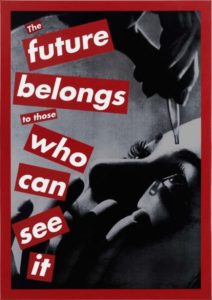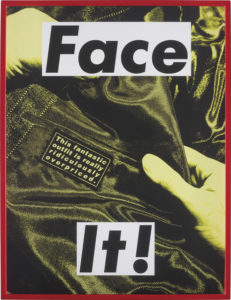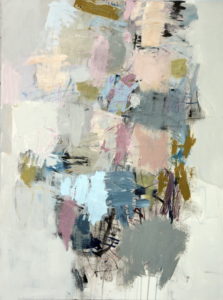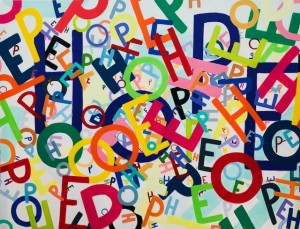Dear Artist,
Three Mondays in a row, an email appeared with an invitation to submit to an online gallery for exposure to an international audience. The middle of the first email was padded with generic compliments and a mission statement about empowering artists and enhancing worldwide visibility. No other details were provided. At the end, there was a link to a short news article about the site’s start-up funding (2 million euros.) By the time the third email arrived, the language had moved from “I sincerely admire this unique style in your artworks, and the strong power that emerges from it” to “Did you receive my last emails?” Peter told me it was a bot, but the pressure was mounting. Not wanting to be rude, I replied:

Untitled (The future belongs to those who can see it), 1997
Silkscreen on vinyl
85 × 60 inches
by Barbara Kruger (b.1945)
“Thanks for your emails. I’ve read the information in your attached links regarding the platform’s background and founder and have browsed the site. Could you please send more information including commission structure for artists, inventory/shipping details plus target audience and curatorial programming? What is the average price point and how many artists do you wish to represent? Lastly, do you sell only original art or do you also sell reproductions? I look forward to hearing more from you.” That was Monday. Since then, the bot has been silent. “Our Age of Anxiety,” wrote Marshall McLuhan, “is, in great part, the result of trying to do today’s job with yesterday’s tools and yesterday’s concepts.”

I Shop Therefore I Am, 1990
Photolithograph on paper shopping bag
20 1/2 × 14 1/2 inches
by Barbara Kruger
Still waiting, I googled “online art platforms” and fell into a mega mall: Saatchi Art, Artfinder, Vango, UGallery, Absolut Art, Tappan Collector, Deviant Art, Artsy, 1st Dibs, Artspace, artnet, Dribbble, Artfire, Artplode, Cafe Press, EBay, Etsy, Fine Art America, Sotheby’s Home, Art.com, Singulart. While the fine print was buried, each seemed to offer a little something different from the next; some selling warehouse-style accessibility and democratization; others, exclusive access and boutique curation; most, exposure, aggregation and convenience. On some sites, collections were organized by colour or subject matter descriptors, or by price or size, like a row of otherwise uniformly pulverized baby foods, merchandised by meat and vegetable combo. One site featured a “make us an offer” box. And the platforms weren’t just for artists. The galleries were there, too, bumping up and down in a popularity algorithm — even the choicest cuts hamburgered by the conveyor belt. Still waiting, I googled myself and scrolled through recent work, bedded in a blinding marketplace of possibly almost every artist, ever. “It is the framework which changes with each new technology,” wrote McLuhan, “and not just the picture within the frame.”

FACE IT (Yellow), 2007
Pigment print on Hahnemühle photo rag, in artist’s frame
43 × 33 inches
by Barbara Kruger
Sincerely,
Sara
PS: “You’re either on the bus or off the bus.” (Tom Wolfe)
Esoterica: As the world reopens, it seems the first place to be intimate with an In Real Life cultural experience could be a commercial gallery or open studio. A gallery can open its doors and offer to an individual, a private aesthetic encounter. A gallery is not in the business of crowds. Before concerts, Broadway shows, museum blockbusters, art fairs, and the World Series, a bricks and mortar gallery will invite you away from the screen. “We become what we behold. We shape our tools and then our tools shape us.” (Marshall McLuhan)
Have you considered a Premium Artist Listing? With each letter, an artist is featured at the bottom of this page. The Premium Artist Listings are a means of connecting artist subscribers through their work. Proceeds from each listing contribute to the production of The Painter’s Keys.
“Listen: our culture is saturated with irony whether we know it or not.” (Barbara Kruger)
Featured Workshop
 Have some experience painting, but want to explore the elements of non-objective painting in more depth, increase your confidence and creative intelligence? Boldly Abstract 2 is for you. As in Boldly Abstract 1 we will cover aspects of color, composition and mark making however through a series of more challenging exercises meant for those with more painting experience. Learn how to fix an unsatisfying painting. We will share our extensive knowledge of the art business with you, covering such topics as the mechanics of running your own art business, applying to galleries and the ins and outs participation in art fairs.
Have some experience painting, but want to explore the elements of non-objective painting in more depth, increase your confidence and creative intelligence? Boldly Abstract 2 is for you. As in Boldly Abstract 1 we will cover aspects of color, composition and mark making however through a series of more challenging exercises meant for those with more painting experience. Learn how to fix an unsatisfying painting. We will share our extensive knowledge of the art business with you, covering such topics as the mechanics of running your own art business, applying to galleries and the ins and outs participation in art fairs.
August 19, 20 and 21
9 am to 4:30 pm
$950 Bring a friend and save $50 each. Take both workshops and save $100
https://artbycat.com/page/1-Workshops-Prints.html
Featured Artist
Sometimes we see what no one looks for–images that have waited for us to find them. If we are lucky, these images will wait while we try to capture them with paint on canvas. They will probably change as we reach for them. I believe that if we clearly and honestly record what we see, we will be surprised, enriched, and sometimes stunned by what we’ve found.
There is almost always a narrative in my paintings as I believe that a story may be introduced in a scene. The viewer must fill in the before and after with unique eyes and experience, but enough can be presented to set a challenging stage if the work is successful.
Along with being a visual story teller, I’ve been called a colorist, surrealist, patternist, and sometimes a texturist. I’m an Atlanta artist–an oil painter for over twenty-five years–with a studio in Brookhaven. I love working with oils because each painting session results in a new revelation of what they might do. There is a mystical quality to each painting and each day for me.





12 Comments
You can also be run over by a bus and even dragged by a bus. Probably 17 choices about that bus.
Mr. Wolfe and his asinine binary thinking.
I wish someone would help me get OFF Saatchi. I’ve asked innumerable times and they never get back to me.
Can’t you just take your listings down?
I was interested in your research and possible solution- a real live commercial gallery. It seems in my neck of the woods galleries are thinking about or starting to reopen but in starts and stops. I wonder too about risks the galleries must struggle with bs the rewards they may obtain.
Robin, you are so right about the fits of start and stops for opening physical commercial gallery spaces. I want to have the gallery open as I think it is a great low risk activity for people and it works well when people are trickling through. But then comes Saturday and the Farmers Market when the village area is bustling. Then, our gallery and other shops in the building, must have people waiting outside to come in, 2 at a time with masks. We do keep the gallery open by appointment and by chance but there is no safe way to have 40 people through in two hours, like we have during previous summer Saturdays. This is where the extra time and expense of having online show space will hopefully make a difference. So far, it seems to be working reasonably well but this might be because I have always shown and sold work online since as early as 2010. In fact, way more work goes off to art collectors from online viewing than ever has from just the physical gallery space. Rarely does a serious purchaser enter the physical gallery without already having done their online homework first. This is even more true right now when it is best to make an appointment to visit. Often work is put on hold in advance and a visit is booked to make a final selection and decision. These are tough and unusual times but we are going to get through it, somehow. For independent artists, I think there is a greater opening up to have access to art collectors than even before the pandemic by choosing a few online tools that are within the artist’s annual budget and working them hard and consistently. This could be a simple as a Facebook business page. As for reward, so far, art sales are slightly greater than in previous years. If (and for as long as we can) we just keep going and keep our eyes and ears open for pivot opportunities, they will be there. We just need to keep looking and remove as many self-imposed barriers as possible. If something doesn’t seem to be working after a good solid effort, ditch it and try something else. Possibly artists have the most experience with these kinds of risks because it is a requirement of the creative process.
I Meant versus the rewards…… oops
Being on a serene island off the southwest coast of British Columbia, Canada, I have always loved the ability to use online platforms ad social media to get artwork out into the world. It has only been this past three years that I have moved from inviting people to my home studio to having a physical gallery space in the village area of our community with 1,000 full-time residents that balloons to triple this size during the summer months. I find there is little separation between the walls of the gallery and the screen for viewing artwork. People come into the gallery and then look up other work online on their phones or I find it for them on my iPad Pro. Sometimes they select work in advance online for me to bring into the gallery before they make a final decision. Both ways of viewing work are tools for showing paintings to potential art collectors. Neither can do their jobs well without our human connection, building relationships and trust. This last aspect is what is most important and way more important than the hottest new way to share ones work… even though setting up a 3D virtual gallery experience is kind of fun! I have selected the website link for the Artsy Terrill Welch Gallery profile. Artsy works well for the gallery’s needs because it is easy to use and allows for easy showing of work from multiple artists. From there, I can reach out to serious fans and art collectors to present the work in the best way possible… for now. But it isn’t the most important aspect. Doing our best work and then being willing to share our process and finished pieces using a variety of methods, while keeping the overhead as low as possible, over a long period of time, seems as if it is the best long game strategy.
I do love the way the subject is always presented without conclusion, as in ‘here’s some thoughts, draw your own values out of it’. It always leads me to questions of my own, and this one is no different. I too struggle with knowing what tools to use to promote my art. At every level it seems to be at the expense of the artist, with plenty of promise of sales, exposure, legitimacy, etc., but little data to show actual real life success. Everything from artists’ societies, art calls, online galleries, and even The Painters’ Keys with the Premium Artist Listings all cost the artist a fair chunk when it is all added up. At this point the brick and mortar galleries are opening, but it feels like a big question mark about what the art market will be like heading into the fall. How much do we spend getting art in front of a wider audience? As the stacks of paintings build up against the walls of my studio, I am certainly living in an ‘age of anxiety’ for my creative practice.
I’ve felt that to a certain extent that many on-line resources could be categorized as “advertising”. This requires some calculation because networking and public relations are also part of the marketing mix and we often have difficulty counting the costs of “digital “events” and their real value beyond the “love, and likes”. On the other hand, I’m all for anything that helps to reinforce value as value begins to be quantified. But I have to admit to losing interest in the multitude of sites making all sorts of promises and new approaches. Clutter is the problem of the internet. But not the problem of meaningful face to face networking and sincere personal connections. If you want to be on the bleeding edge of the business you had better be prepared to innovate at the expense of your own aesthetic drives.
Saatchi has been very good for me in the past, though not recently. It is a site that has my respect. In the good news front, I have heard from numerous galleries, including one that I am in on an island in the Northwest, that they are having one of their best summers and possibly years in the middle of this mess. People who would be doing major travels are staying home and buying art and redoing their houses. Late Stage Capitalism has its perks!
Love this post.
Thanks Sara